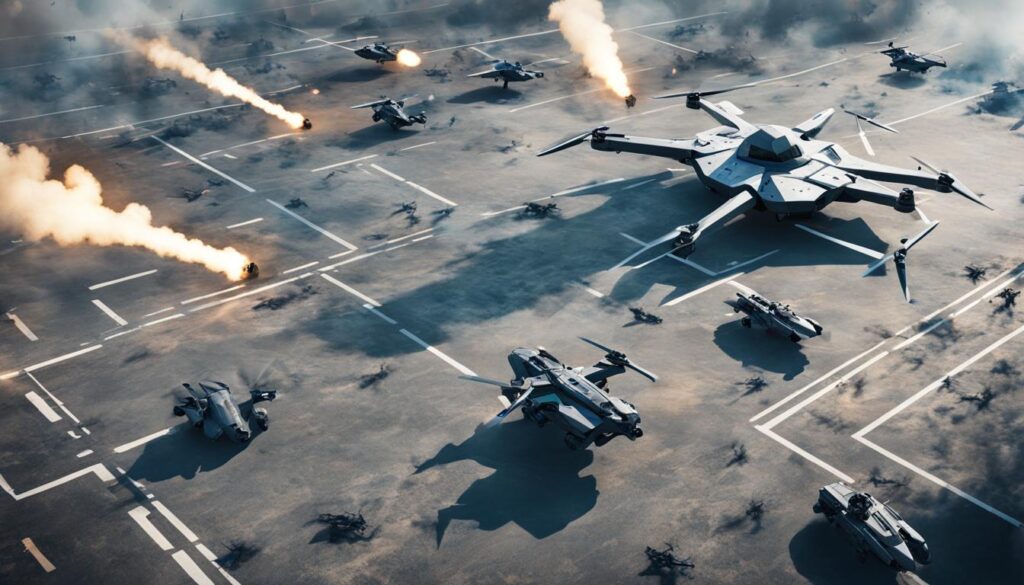Artificial intelligent robots have the potential to revolutionize the field of military technology, offering new possibilities for reducing military spending without compromising on defense capabilities. The integration of AI robots in various military operations can provide cost-effective and efficient solutions, leading to significant savings in defense budgets.
The development of AI robots allows for advancements in reconnaissance missions, where robots can gather crucial information on the battlefield, keeping soldiers out of harm’s way. This not only ensures the safety of military personnel but also provides commanders with valuable data for strategic decision-making.
However, it is important to acknowledge the challenges that come with the implementation of AI robots in the military. Leadership changes, budget cuts, and technological hiccups can hinder the seamless integration of these advanced technologies. Nevertheless, recognizing the potential benefits and addressing these challenges can pave the way for a more cost-effective and efficient defense strategy.
Contents
- 1 The Role of Army Futures Command in Modernization
- 2 Pentagon’s Investment in Autonomous Weapons and Advanced Technologies
- 3 The Benefits and Challenges of AI-empowered Unmanned Systems
- 4 Conclusion
- 5 FAQ
- 5.1 How can artificial intelligent robots reduce military spending?
- 5.2 What is the role of Army Futures Command in modernization?
- 5.3 How is the Pentagon investing in autonomous weapons and advanced technologies?
- 5.4 What are the benefits and challenges of AI-empowered unmanned systems?
- 5.5 How can military spending be optimized with artificial intelligent robots?
- 6 Source Links
Key Takeaways:
- Artificial intelligent robots can significantly impact military spending by providing cost-effective defense solutions.
- The integration of AI robots in reconnaissance missions reduces the risk to soldiers and provides valuable data to commanders.
- Leadership changes, budget cuts, and technological challenges may affect the implementation of AI robots in the military.
- Addressing these challenges is crucial to optimize the benefits of AI robots in military operations.
- The development and deployment of AI robots require careful consideration of the benefits, risks, and ethical implications.
The Role of Army Futures Command in Modernization
Army Futures Command plays a crucial role in the modernization efforts of the U.S. Army. With a focus on bringing new technologies to soldiers at an accelerated pace, this command aims to reform the broken acquisition pipeline and drive innovation in defense.
Experimentation and prototyping are key components of Army Futures Command’s approach. By testing and refining new technologies early in the development process, the command seeks to reduce risks and increase the chances of success. This emphasis on experimentation also allows for soldier feedback to be incorporated into the design process, ensuring that the final products meet the needs of those who will use them on the battlefield.
In line with its commitment to modernization, Army Futures Command adopts a modular systems approach with open standards. This approach enables upgrades and fosters competition among vendors, resulting in cost-effective solutions. By harnessing the power of modular systems, the command can stay ahead of the rapidly evolving technological landscape and deliver cutting-edge capabilities to the Army.
“Experimentation and prototyping are crucial in Army Futures Command’s mission to accelerate modernization and deliver new capabilities to soldiers faster.”
Progress and Setbacks
While Army Futures Command has made significant progress in its modernization efforts, there have also been setbacks along the way. The command recognizes that innovation comes with inherent risks and challenges, but it remains committed to overcoming these obstacles to achieve its goals.
By embracing experimentation and prototyping, Army Futures Command has been able to push the boundaries of what is possible in defense technology. This approach has allowed for quick iteration and improvement, resulting in the timely delivery of new capabilities to soldiers.
However, it is essential to acknowledge that the road to modernization is not without its challenges. Factors such as leadership changes, budget constraints, and technological hiccups can impact the implementation of new technologies. Nonetheless, Army Futures Command continues to navigate these challenges with resilience and determination, recognizing that the rewards of modernization far outweigh the obstacles.
Achievements of Army Futures Command
| Program | Progress |
|---|---|
| Next-Generation Squad Weapon | Successful prototype testing |
| Soldier Borne Sensor | Improved situational awareness for soldiers |
| Advanced Hypersonic Weapon | Development of long-range precision strike capabilities |
| Artificial Intelligence Integration | Enhanced decision-making and analytics capabilities |
The table above showcases some of the achievements of Army Futures Command’s modernization programs. These advancements demonstrate the command’s commitment to equipping the Army with innovative and effective technologies.
Image: Army Futures Command driving modernization through experimentation and prototyping.
Pentagon’s Investment in Autonomous Weapons and Advanced Technologies
The Pentagon has recognized the importance of autonomous systems, artificial intelligence, and advanced technologies in countering rivals like Russia and China. In line with this recognition, the budget request for fiscal year 2024 reflects significant investments in autonomous weapons and unmanned systems.
The Navy is specifically planning to increase spending on large unmanned surface vehicles, while the Army aims to boost robotics development. Furthermore, the overall defense budget includes funding for AI systems, hypersonic weapons, and supply chain risk-reduction. These strategic investments are deemed necessary to ensure readiness in future high-intensity conflicts.
The advancements in autonomous weapons and advanced technologies allow for more precise and efficient operations, reducing the risks faced by military personnel while enhancing mission success rates. By leveraging these cutting-edge capabilities, the military can maintain a competitive edge and swiftly adapt to contemporary security challenges.
Benefits of Autonomous Weapons and Advanced Technologies:
- Enhanced situational awareness and decision-making capabilities.
- Reduced reliance on human operators in high-risk or hazardous environments.
- Improved operational efficiency and mission success rates.
Challenges of Autonomous Weapons and Advanced Technologies:
- Ethical considerations surrounding the use of autonomous weapons.
- Cybersecurity vulnerabilities and the potential for technological exploitation.
- Ensuring proper training and integration of these technologies into military operations.
Investing in autonomous weapons and advanced technologies is a critical aspect of defense modernization. While it presents both opportunities and challenges, the Pentagon’s forward-thinking approach aims to harness the potential of these advancements to safeguard national security effectively.
“Our investment in autonomous weapons and advanced technologies allows us to maintain the technological edge needed to protect our country and allies in an ever-evolving security landscape.” – Secretary of Defense, [Name]

The Benefits and Challenges of AI-empowered Unmanned Systems
The Navy is particularly focused on developing AI-empowered unmanned systems to augment combat capabilities. Unmanned surface vehicles, unmanned undersea vehicles, and unmanned aerial vehicles are being developed to perform various missions at lower costs and with fewer casualties. These systems have the potential to enhance the Navy’s combat capabilities in contested areas.
These AI-empowered unmanned systems provide numerous benefits. They can gather intelligence and perform surveillance without putting human lives at risk. This allows commanders to make informed decisions based on real-time data, improving operational effectiveness. Moreover, these systems can operate in harsh environments that may be too dangerous or challenging for human operators, such as in deep-sea or high-altitude missions.
Another advantage of AI-empowered unmanned systems is their cost-effectiveness. Compared to manned assets, unmanned systems require less infrastructure and maintenance, making them more affordable to deploy and operate. Additionally, these systems can be easily upgraded and adapted to evolving threats, providing flexibility and saving costs in the long run.
| Benefits of AI-empowered Unmanned Systems |
|---|
| Enhanced situational awareness |
| Reduced risk to human operators |
| Operational effectiveness |
| Cost-effectiveness |
| Flexibility and adaptability |
However, the development and deployment of AI-empowered unmanned systems also come with challenges. One major concern is the ethical implications of using autonomous weapons. Questions arise regarding the decision-making process of these systems and the potential for unintended harm. It’s essential to ensure that AI-powered unmanned systems adhere to strict rules of engagement and are deployed responsibly to prevent any misuse or escalation of conflicts.
Operational challenges also need to be addressed. Maintaining and securing the communication channels between these systems and their remote operators are critical to ensuring optimal performance. The Navy should invest in robust and secure communication infrastructure to prevent any disruptions or potential cyber threats that could compromise the operation of these unmanned systems.
In conclusion, AI-empowered unmanned systems offer significant benefits for the Navy in terms of enhanced combat capabilities and cost-effectiveness. However, the ethical and operational challenges must be carefully managed to ensure the responsible and effective use of these autonomous weapons. The Navy’s budget allocation for the design, production, and deployment of combat-ready unmanned surface vehicles and unmanned undersea vehicles demonstrates its commitment to harnessing the potential of AI in military operations.

Conclusion
Artificial intelligent robots have emerged as a promising solution to reduce military spending while enhancing defense strategies. By harnessing the power of automation in military operations, these advanced technologies offer cost-effective and efficient alternatives for safeguarding national security.
The significant investments in autonomous weapons and advanced technologies reflect the military’s proactive approach to prepare for future conflicts and maintain a strategic advantage. The integration of artificial intelligence and robotics in defense systems holds the potential to revolutionize military operations by minimizing risks to human life while maximizing combat capabilities.
However, as with any innovation, there are challenges that must be addressed. Ensuring the readiness and reliability of artificial intelligent robots for the battlefield is crucial. Additionally, careful consideration of ethical considerations is necessary to navigate the evolving landscape of automation in military operations.
The optimization of defense spending and strategies requires a balanced assessment of the benefits and risks posed by artificial intelligent robots. By effectively leveraging these technologies, the military can achieve operational efficiency, advanced situational awareness, and enhanced combat capabilities, ultimately achieving national security goals in a cost-effective manner.
FAQ
How can artificial intelligent robots reduce military spending?
Artificial intelligent robots have the potential to provide cost-effective and efficient defense solutions, ultimately reducing military spending.
What is the role of Army Futures Command in modernization?
Army Futures Command aims to reform the Army’s acquisition pipeline, accelerate modernization programs, and deliver new technologies to soldiers faster through experimentation, prototyping, and incorporating soldier feedback.
How is the Pentagon investing in autonomous weapons and advanced technologies?
The Pentagon has included significant investments in autonomous weapons, unmanned systems, AI systems, hypersonic weapons, and supply chain risk-reduction in its budget request for fiscal year 2024.
What are the benefits and challenges of AI-empowered unmanned systems?
AI-empowered unmanned systems can augment combat capabilities, perform various missions at lower costs, and reduce casualties. However, their development and deployment raise ethical and operational challenges that need to be addressed.
How can military spending be optimized with artificial intelligent robots?
Military spending can be optimized by carefully considering the benefits and risks of artificial intelligent robots, ensuring their readiness for the battlefield, and addressing ethical considerations during their development and implementation.
Source Links
- https://www.defensenews.com/land/2022/01/10/the-us-army-put-experimentation-and-prototyping-at-the-core-of-its-modernization-initiative-is-it-working/
- https://www.armscontrol.org/act/2019-04/news/pentagon-asks-more-autonomous-weapons
- https://www.c4isrnet.com/battlefield-tech/2023/03/13/pentagons-historic-rd-request-has-billions-for-advanced-networks-ai/




